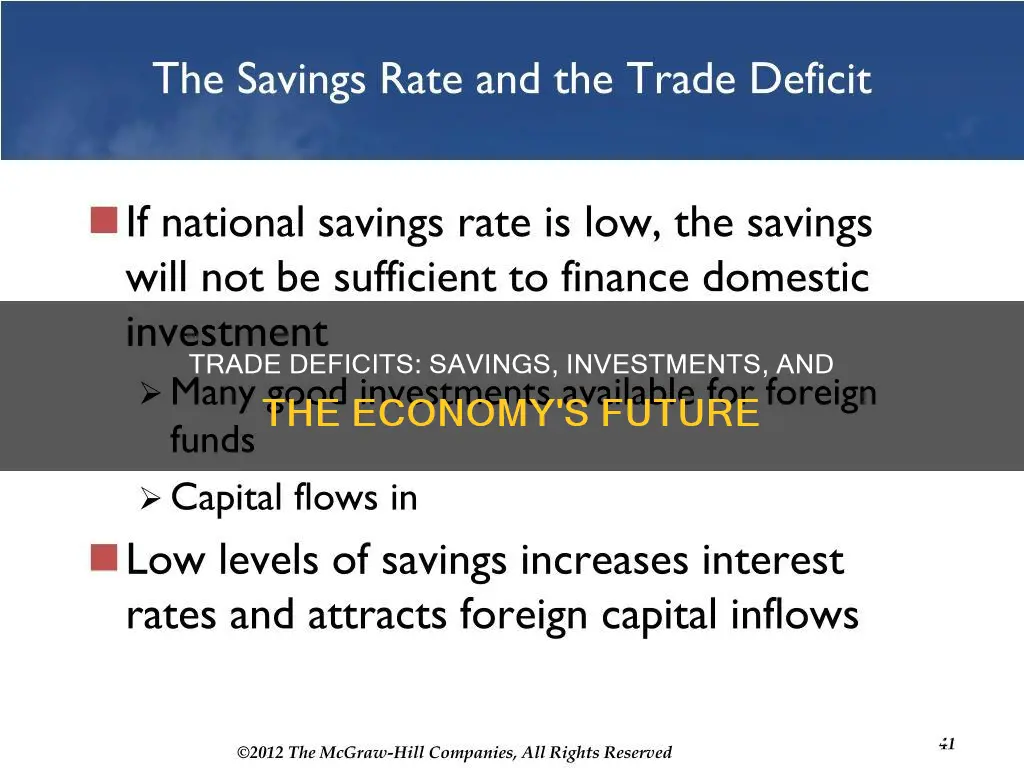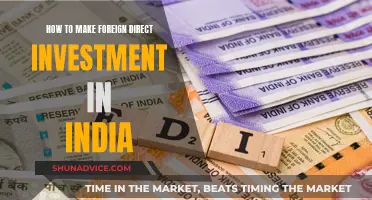
A trade deficit occurs when a country's imports exceed its exports, and it is often a concern for governments and economists. While a trade deficit is not inherently harmful to a country's economy, it can become detrimental in the long run if it leads to a decrease in domestic production and an increase in trade deficits. A country's savings and investments play a crucial role in maintaining a healthy balance of trade. Savings refer to money left after expenses, while investments are funds intended for conversion into capital. According to Keynes' theory, an economy is in equilibrium when savings are equal to investments, and this balance is crucial during trade deficits as it drives economic growth.
| Characteristics | Values |
|---|---|
| Trade deficit | Occurs when a country's total imports exceed its exports |
| Trade surplus | Occurs when a country's total exports outweigh its imports |
| Savings | Money left over after accounting for expenses |
| Investments | Money intended for conversion into capital |
| Savings and investments balance | Refers to the balance of national savings and national investments, which is equal to the current account |
| Keynes theory | An economy is in equilibrium when saving is equal to investment |
| Impact of trade deficit | Provides opportunities for domestic businesses to produce quality goods and services, decreases inflation rate, attracts foreign investment, may lead to job losses and reduced manufacturing in the long run |
What You'll Learn

A trade deficit occurs when a country's imports exceed exports
A trade deficit occurs when a country's imports exceed its exports. This is also referred to as a negative balance of trade (BOT). The balance can be calculated on different categories of transactions, including goods, services, and goods and services.
A trade deficit can be beneficial in the short term, as it allows a country to consume more than it produces, helping to avoid shortages of goods and other economic problems. It also provides opportunities for domestic businesses to produce quality goods and services to match foreign products, which can help drive down inflation.
However, in the long run, a trade deficit may not be beneficial. When imports increase beyond a certain level, prices of goods and services can decrease due to high competition. This can make it difficult for domestic companies to manufacture goods at a profit, leading to job losses and reduced production.
The fundamental cause of a trade deficit is an imbalance between a country's savings and investment rates. This can be influenced by factors such as government spending, exchange rates, and the strength of the domestic economy.
While trade deficits are often viewed negatively, they can have potential benefits for an economy. For example, a trade deficit may reflect strong domestic demand, economic growth, and access to a wider range of goods and services for consumers.
Investing Life Savings: Strategies for Long-Term Financial Growth
You may want to see also

A trade surplus occurs when exports outweigh imports
A trade surplus occurs when a country's exports are greater than its imports, also known as a positive trade balance. This indicates that there is a high demand for a country's goods and services in the global market, which can lead to an increase in prices and a strengthening of the domestic currency. A trade surplus can also result in employment creation and economic growth for the country.
The balance of trade is the difference between the monetary value of a nation's exports and imports over a certain period. It is not a measure of whether exports and imports are "in balance" but rather indicates the flow of exports and imports over a given period. A trade surplus occurs when exports outweigh imports, while a trade deficit occurs when imports are greater than exports.
A trade surplus represents a net inflow of domestic currency from foreign markets. It can be calculated by subtracting the total value of imports from the total value of exports. A trade surplus can have a positive impact on a country's economy, as it may lead to increased employment and economic growth. However, it can also result in higher prices and interest rates within the economy, as well as an appreciation of the domestic currency.
A country with a trade surplus has more control over its currency through trade, which can influence its value in the global markets. A trade surplus can strengthen a country's currency relative to others, affecting currency exchange rates. This is influenced by the proportion of goods and services traded by a country compared to other nations, as well as other market factors.
A trade surplus indicates that a country's goods are in high demand globally, which can create jobs and fuel economic growth. However, this does not mean that countries with trade deficits are necessarily in a weaker economic position. Each economy operates differently, and some of the strongest economies in the world run trade deficits, indicating that trade is not a zero-sum game.
529 Savings Plans: Smart Investment Strategies, per Forbes
You may want to see also

Savings and investments are closely related but distinct
Savings refers to setting aside a portion of one's income for short-term goals, emergencies, or future purchases. The primary purpose is to accumulate easily accessible funds that can be used when needed. Savings are typically kept in low-risk, liquid instruments like bank accounts, certificates of deposit (CDs), or cash equivalents. The focus is on preserving capital and maintaining financial security, with stability and peace of mind being key advantages. However, savings accounts generally offer minimal growth potential due to lower interest rates compared to other investment options. Additionally, savings may not effectively protect against inflation, as the interest earned may not keep pace with rising prices, leading to a potential loss in real value over time.
On the other hand, investing involves allocating money to assets such as stocks, bonds, real estate, mutual funds, or other financial instruments with the expectation of generating returns over the long term. The goal of investing is to grow wealth by taking calculated risks. Investments are typically chosen based on an individual's goals, risk tolerance, and time horizon. Investing is suitable for long-term financial goals like retirement planning, funding education, or building substantial wealth. The longer time horizon allows for potential compounding of returns, enabling investors to weather market fluctuations. Historical data indicates that certain investments, like stocks and real estate, have provided returns that outpace inflation, making them a hedge against its erosive effects.
While savings provide liquidity and security for short-term needs, investing offers the potential for significant growth and wealth accumulation over time. The distinction between savings and investments is particularly important in the context of a country's economy. A country's savings and investments play a crucial role in maintaining a healthy balance of trade. During trade deficits, for instance, the capital generated from savings is essential for driving economic growth. According to the Keynes theory, an economy is in equilibrium only when savings are equal to investments.
Invest Your Savings Wisely: The Power of ETFs
You may want to see also

Savings and investments are key to maintaining a healthy balance of trade
A country's savings and investments are key to maintaining a healthy balance of trade. A healthy balance of trade is crucial for sustaining a country's economy. When a country's total imports exceed its exports, it results in a trade deficit, which can have both short-term benefits and long-term drawbacks. While a trade deficit may not be inherently harmful in the short term, indicating a growing economy and attracting foreign investment, it can lead to challenges if it persists over an extended period.
The balance between savings and investments becomes critical during a trade deficit. Savings refer to the excess income after expenses, while investments are funds designated for conversion into capital, involving a degree of risk. In macroeconomics, the equilibrium between savings and investments is vital, as it impacts economic growth. According to Keynesian theory, an economy is in balance when savings are equal to investments, generating capital that is crucial during trade deficits to drive economic growth.
To maintain a healthy balance of trade, it is essential to understand the factors contributing to a trade deficit. A trade deficit occurs when a country's production of domestic goods and services falls short of local demand, leading to increased imports. Additionally, an increase in consumers' purchasing power can create a demand for expensive foreign products, further widening the trade deficit. However, a trade deficit can provide opportunities for domestic businesses to enhance their products and services to match foreign competition, leading to a more diverse market and lower inflation rates.
In the long run, a persistent trade deficit may have negative consequences. When imports increase significantly, the resulting high competition can drive down prices, making it challenging for domestic companies to manufacture goods at lower prices. This can lead to job losses and a decrease in the production of goods and services, perpetuating the cycle of trade deficit as the country becomes increasingly reliant on imports.
To offset a trade deficit, a country must focus on increasing savings and investments. By depositing savings into financial institutions, they can be converted into investments for businesses, stimulating economic growth. Additionally, a country can utilise its savings to offset the deficit, demonstrating the importance of maintaining a balance between savings and investments to ensure a healthy balance of trade.
Invest Your Savings Wisely: A California Guide
You may want to see also

A trade deficit can be beneficial in the short term
For instance, a trade deficit can be beneficial when a country's production of domestic goods and services is not enough to meet local demand. In this case, a trade deficit provides opportunities for domestic businesses to produce quality goods and services to match foreign products. With domestic products available at lower prices, the inflation rate decreases, and consumers benefit from a wider variety of goods. This increase in imports also indicates a fast-growing economy, which in turn attracts more foreign investment.
Additionally, a trade deficit can be financed by foreign investment inflows, which can stimulate domestic investment and economic activity. This foreign lending and investment can be seen as a vote of confidence in the country's economy and a source of long-term economic growth, provided that the borrowed money or foreign investment is used wisely. For example, in the 1800s, the United States used foreign investment in railroads and other public infrastructure to develop economically.
However, it is important to note that while a trade deficit can have potential benefits in the short term, it may not be beneficial in the long run. If imports increase beyond a certain extent, prices of goods and services may decrease due to high competition, making it difficult for domestic companies to manufacture and produce goods at low prices. This can lead to job losses and a decrease in the production of domestic goods and services, resulting in an even larger trade deficit.
Investing Young: Better Than Saving?
You may want to see also
Frequently asked questions
A trade deficit occurs when a country's total imports exceed its exports. In other words, a trade deficit occurs when a country buys more goods and services than it sells.
Savings and investments are closely related and important in macroeconomics. Savings is the excess income after expenditure, while investment is the money intended for conversion into capital.
A country can address a trade deficit by increasing its savings and investments. This can be done by depositing savings into intermediaries like banks and financial institutions, which can then be converted into investments for businesses.







